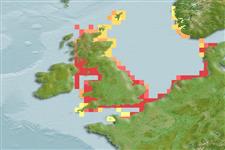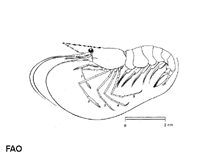Palaemon longirostris Milne-Edwards, 1837
Delta prawn| Native range | All suitable habitat | Point map | Year 2050 |

|
| This map was computer-generated and has not yet been reviewed. |
| Palaemon longirostris AquaMaps Data sources: GBIF OBIS |
Classification / Names Common names | Synonyms | CoL | ITIS | WoRMS
Malacostraca | Decapoda | Palaemonidae
Environment: milieu / climate zone / depth range / distribution range Ecology
Benthic; catadromous; freshwater; brackish; depth range 0 - 17 m (Ref. 101283). Temperate, preferred 11°C (Ref. 107945); 61°N - 27°N, 14°W - 42°E
Distribution Countries | FAO areas | Ecosystems | Occurrences | Introductions
Eastern Atlantic and the Mediterranean. Introduced in Baltic and Black Sea.
Length at first maturity / Size / Weight / Age
Maturity: Lm ? range ? - ? cm Max length : 7.0 cm TL male/unsexed; (Ref. 8)
Common in European estuaries. Mostly inhabits freshwater throughout the year but migrates to estuarine brackish waters to reproduce (Ref. 82147).
Life cycle and mating behavior Maturity | Reproduction | Spawning | Eggs | Fecundity | Larvae
Inhabits freshwater but migrates o estuarine brackish waters to reproduce. The development of the whole larval stage takes place in mid estuarine waters (Ref. 82147); juveniles migrates back to freshwater (Ref. 82145).
Main reference
References | Coordinator | Collaborators
Grabowski, M. 2006. (Ref. 2756)
IUCN Red List Status (Ref. 130435)
CITES status (Ref. 108899)
Not Evaluated
CMS (Ref. 116361)
Not Evaluated
Threat to humans
Human uses
Fisheries: commercial; bait: occasionally
FAO - Fisheries: landings | FishSource | Sea Around Us
Tools
More information
Internet sources
BHL | BOLD Systems | CISTI | DiscoverLife | FAO(Fisheries: ; publication : search) | Fishipedia | GenBank (genome, nucleotide) | GloBI | Gomexsi | Google Books | Google Scholar | Google | PubMed | Tree of Life | Wikipedia (Go, Search) | Zoological Record
Estimates based on models
Preferred temperature
(Ref. 115969): 10.6 - 12.5, mean 11.5 (based on 86 cells).
Resilience
(Ref. 69278):
High, minimum population doubling time less than 15 months (K=0.51-0.62).
Nutrients: Calcium = 109 [35, 184] mg/100g; Iron = 1.59 [1.21, 1.97] mg/100g; Protein = 20.2 [19.2, 21.3] %; Omega3 = 0.285 [0.185, 0.386] g/100g; Selenium = 48.3 [-31.7, 128.3] μg/100g; VitaminA = 0 μg/100g; Zinc = 1.79 [1.17, 2.40] mg/100g (wet weight).



